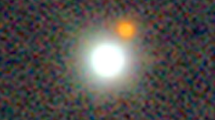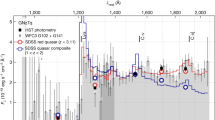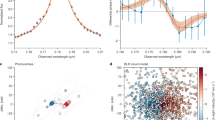Abstract
Supermassive black holes underwent periods of exponential growth during which we see them as quasars in the distant Universe. The summed emission from these quasars generates the cosmic X-ray background, the spectrum of which has been used to argue that most black-hole growth is obscured1,2. There are clear examples of obscured black-hole growth in the form of ‘type-2’ quasars3,4,5, but their numbers are fewer than expected from modelling of the X-ray background. Here we report the direct detection of a population of distant type-2 quasars, which is at least comparable in size to the well-known unobscured type-1 population. We selected objects that have mid-infrared and radio emissions characteristic of quasars, but which are faint at near-infrared and optical wavelengths. We conclude that this population is responsible for most of the black-hole growth in the young Universe and that, throughout cosmic history, black-hole growth occurs in the dusty, gas-rich centres of active galaxies.
This is a preview of subscription content, access via your institution
Access options
Subscribe to this journal
Receive 51 print issues and online access
$199.00 per year
only $3.90 per issue
Buy this article
- Purchase on Springer Link
- Instant access to full article PDF
Prices may be subject to local taxes which are calculated during checkout


Similar content being viewed by others
References
Worsley, M. A., Fabian, A. C., Barcons, X., Mateos, S. & Hasinger, G. The (un)resolved X-ray background in the Lockman Hole. Mon. Not. R. Astron. Soc. 354, 720–726 (2004)
Fabian, A. C. The obscured growth of massive black holes. Mon. Not. R. Astron. Soc. 308, L39–L43 (1999)
Antonucci, R. Unified models for active galactic nuclei and quasars. Annu. Rev. Astron. Astrophys. 31, 473–521 (1993)
Rowan-Robinson, M. et al. A high-redshift IRAS galaxy with huge luminosity—hidden quasar or protogalaxy? Nature 351, 719–721 (1991)
Norman, C. et al. A classic Type 2 quasar. Astrophys. J. 571, 218–225 (2002)
Wolf, C. et al. The evolution of faint AGN between z∼1 and z∼5 from the COMBO-17 survey. Astron. Astrophys. 408, 499–514 (2003)
Willott, C. J., Rawlings, S., Blundell, K. M. & Lacy, M. The quasar fraction in low-frequency-selected complete samples and implications for unified schemes. Mon. Not. R. Astron. Soc. 316, 449–458 (2000)
Baker, J. C. et al. Associated absorption in radio quasars. I. C IV absorption and the growth of radio sources. Astrophys. J. 568, 592–609 (2002)
Barger, A. J. et al. The cosmic evolution of hard X-ray-selected active galactic nuclei. Astron. J. 129, 578–609 (2005)
Zakamska, N. L. et al. Candidate type II quasars from the SDSS: III. Spectropolarimetry reveals hidden type I nuclei. Astron. J. (in the press)
Zheng, W. et al. Photometric redshifts of X-ray sources in the Chandra Deep Field South. Astrophys. J. Suppl. Ser. 155, 73–87 (2004)
Alexander, D. M. et al. A Chandra observation of the z = 2.285 galaxy FSC10214 + 4724: Evidence for a Compton-thick quasar? Mon. Not. R. Astron. Soc. 357, L16–L20 (2005)
Broadhurst, T. & Lehar, J. A gravitational lens solution for the IRAS Galaxy FSC 10214 + 4724. Astrophys. J. 450, L41–L44 (1995)
Serjeant, S. et al. A spectroscopic study of IRAS F10214 + 4724. Mon. Not. R. Astron. Soc. 298, 321–331 (1998)
Werner, M. W. et al. The Spitzer Space Telescope Mission. Astrophys. J. Suppl. Ser. 154, 1–9 (2004)
Croom, S. M. et al. The 2dF QSO Redshift Survey-XII. The spectroscopic catalogue and luminosity function. Mon. Not. R. Astron. Soc. 349, 1397–1418 (2004)
Lacy, M. et al. The Infrared Array Camera component of the Spitzer Space Telescope Extragalactic First Look Survey. Astrophys. J. Suppl. Ser. (in the press)
Condon, J. J. et al. The SIRTF First-Look survey. I. VLA image and source catalog. Astrophys. J. 125, 2411–2426 (2003)
Chapman, S. C., Blain, A. W., Smail, I. & Ivison, R. J. A redshift survey of the submillimetre galaxy population. Astrophys. J. 622, 772–796 (2005)
Rawlings, S., Eales, S. & Warren, S. The detection of four high-redshift (0.5 ≤ z ≤ 3.22) radiogalaxies by optical spectroscopy of five blank fields. Mon. Not. R. Astron. Soc. 243, 14–18 (1990)
Alexander, D. M. et al. Rapid growth of black holes in massive star-forming galaxies. Nature 434, 738–740 (2005)
Cirasuolo, M., Celotti, A., Magliocchetti, M. & Danese, L. Is there a dichotomy in the radio loudness distribution of quasars? Mon. Not. R. Astron. Soc. 346, 447–455 (2003)
Miller, P., Rawlings, S. & Saunders, R. The radio and optical properties of the z < 0.5 BQS quasars. Mon. Not. R. Astron. Soc. 263, 425–460 (1993)
Treister, E. et al. Obscured AGN and the X-ray, optical and far-infrared number counts of AGN in the GOODS fields. Astrophys. J. 616, 123–135 (2004)
Lawrence, A. The relative frequency of broad-lined and narrow-lined active galactic nuclei—implications for unified schemes. Mon. Not. R. Astron. Soc. 252, 586–592 (1991)
Simpson, C. A new look at the isotropy of narrow-line emission in extragalactic radio sources. Mon. Not. R. Astron. Soc. 297, L39–L43 (1998)
Simpson, C. The luminosity dependence of the type 1 active galactic nucleus fraction. Mon Not. R. Astron. Soc. 360, 565–572 (2005)
Yu, Q. & Tremaine, S. Observational constraints on growth of massive black holes. Mon. Not. R. Astron. Soc., 965–976 (3352002)
Marleau, F. R. et al. Extragalactic source counts at 24 microns in the Spitzer First Look survey. Astrophys. J. Suppl. Ser. 154, 66–69 (2004)
Bruzual, G. & Charlot, S. Stellar population synthesis at the resolution of 2003. Mon. Not. R. Astron. Soc. 344, 1028 (2003)
Rowan-Robinson, M. A new model for the infrared emission of quasars. Mon. Not. R. Astron. Soc. 272, 737–748 (1995)
Pei, Y. C. Interstellar dust from the Milky Way to the Magellanic Clouds. Astrophys. J. 395, 130–139 (1992)
Acknowledgements
We thank C. Wolf, L. Clewley, H.-R. Klöckner and G. Cotter for discussions. A.M.-S. is grateful to the Council of the European Union for financial support. S.R. and C.S. are grateful to the UK PPARC for a Senior Research Fellowship and an Advanced Fellowship respectively.
Author information
Authors and Affiliations
Corresponding author
Ethics declarations
Competing interests
Reprints and permissions information is available at npg.nature.com/reprintsandpermissions. The authors declare no competing financial interests.
Supplementary information
Supplementary Notes
This contains Supplementary Methods and Supplementary Figure S1. (PDF 139 kb)
Rights and permissions
About this article
Cite this article
Martínez-Sansigre, A., Rawlings, S., Lacy, M. et al. The obscuration by dust of most of the growth of supermassive black holes. Nature 436, 666–669 (2005). https://doi.org/10.1038/nature03829
Received:
Accepted:
Issue Date:
DOI: https://doi.org/10.1038/nature03829
This article is cited by
-
A likely decade-long sustained tidal disruption event
Nature Astronomy (2017)
Comments
By submitting a comment you agree to abide by our Terms and Community Guidelines. If you find something abusive or that does not comply with our terms or guidelines please flag it as inappropriate.



